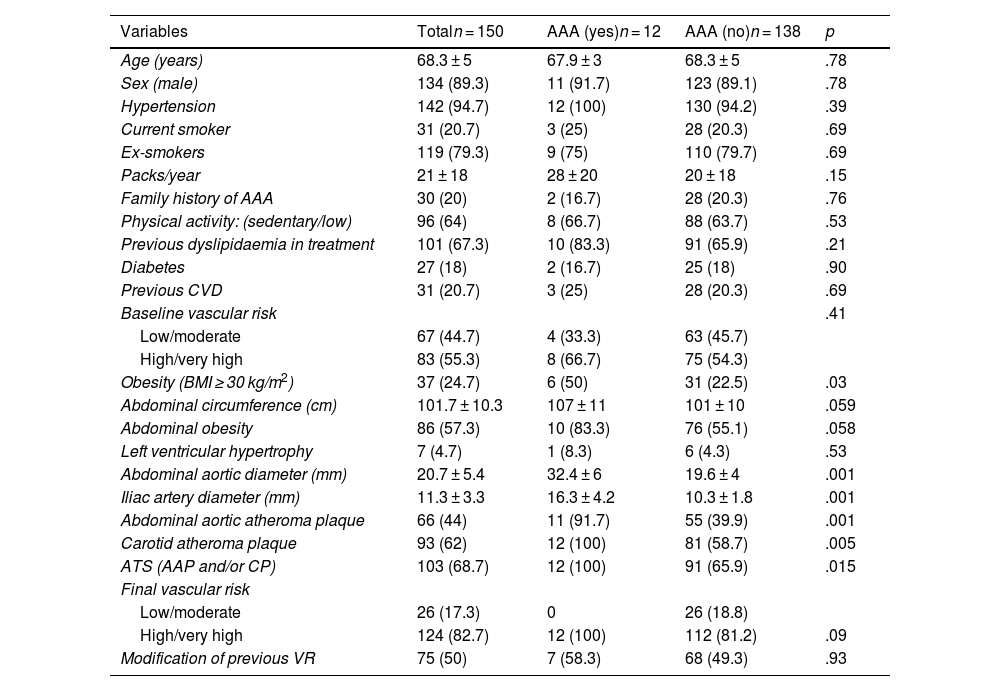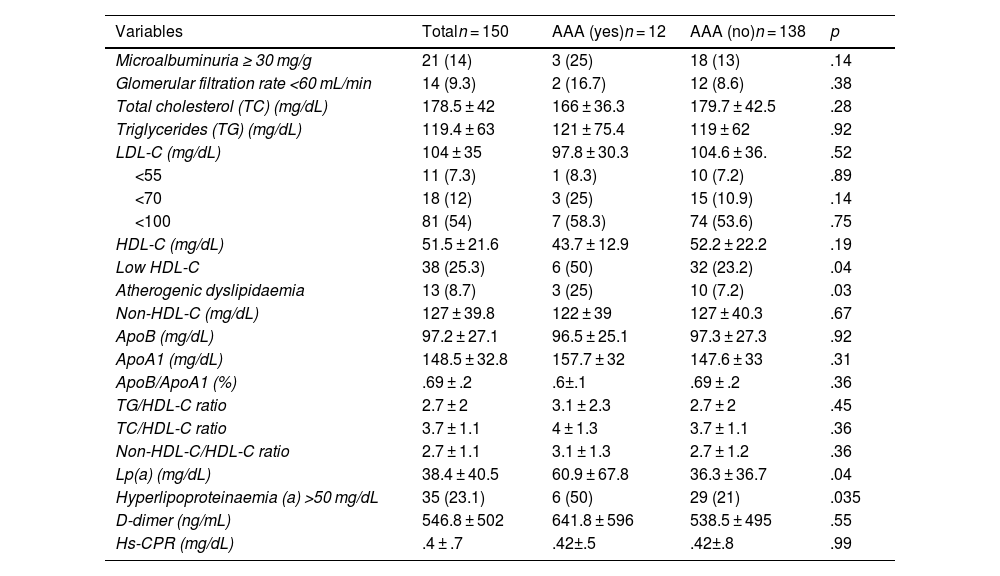Abdominal aortic aneurysm (AAA) constitutes a pathology with high mortality. There is currently no screening program implemented in Primary care in Spain.
ObjectivesTo evaluate the usefulness of ultrasound in the detection of AAA in the at-risk population in Primary care. Secondarily, to identify subjects whose vascular risk (VR) should be reclassified and to determine whether AAA is associated with the presence of carotid plaque and other risk factors.
Material and methodsCross-sectional, descriptive, multicenter, national, descriptive study in Primary care. Subjects: A consecutive selection of hypertensive males aged between 65 and 75 who are either smokers or former smokers, or individuals over the age of 50 of both sexes with a family history of AAA.
MeasurementsDiameter of abdominal aorta and iliac arteries; detection of abdominal aortic and carotid atherosclerotic plaque. VR was calculated at the beginning and after testing (SCORE).
Results150 patients were analyzed (age: 68.3 ± 5 years; 89.3% male). Baseline RV was high/very high in 55.3%. AAA was detected in 12 patients (8%; 95%CI: 4–12); aortic ectasia in 13 (8.7%); abdominal aortic plaque in 44% and carotid plaque in 62% of the participants. VR was reclassified in 50% of subjects. The detection of AAA or ectasia was associated with the presence of carotid plaque, current smoking and lipoprotein(a), p < 0.01.
ConclusionsThe prevalence of AAA in patients with VR is high. Ultrasound in Primary care allows detection of AAA and subclinical atherosclerosis and consequently reclassification of the VR, demonstrating its utility in screening for AAA in the at-risk population.
El aneurisma de aorta abdominal (AAA) constituye una patología de alta mortalidad. En España, en Atención Primaria, no hay programa de cribado implantado actualmente.
ObjetivosEvaluar la utilidad de la ecografía en la detección del AAA en población de riesgo en Atención Primaria. Secundariamente, identificar sujetos cuyo riesgo vascular (RV) debe reclasificarse y determinar si el AAA se asocia a la presencia de placa carotídea y otros factores de riesgo.
Material y métodosEstudio descriptivo transversal, multicéntrico nacional en Atención Primaria.
SujetosSelección consecutiva de varones hipertensos entre 65-75 años, fumadores o exfumadores; o mayores de 50 años de ambos sexos con antecedentes familiares de AAA. Mediciones: Diámetro de aorta abdominal y arterías ilíacas; detección de placa aterosclerótica aórtica abdominal y carotídea. Se calculó el RV inicialmente y tras las pruebas (SCORE).
ResultadosSe analizaron 150 pacientes (edad: 68,3 ± 5 años; 89,3% varones). El RV inicial era alto/muy alto en el 55,3%. Se detectó AAA en 12 pacientes (8%; IC95%:4-12); ectasia aórtica en 13 (8,7%); placa aórtica abdominal en el 44% y placa carotídea en el 62% de los participantes. Se reclasificó el RV en el 50% de los sujetos. La detección de AAA o ectasia se asociaron a la presencia de placa carotídea, tabaquismo actual y lipoproteína(a), p < 0,01.
ConclusionesLa prevalencia de AAA en pacientes con RV es elevada. La ecografía en Atención Primaria permite detectar AAA y aterosclerosis subclínica y consecuentemente reclasificar el RV, demostrando su utilidad en el cribado de AAA en población de riesgo.








